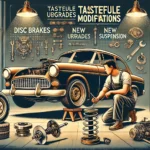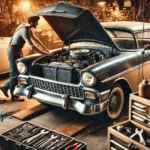Owning a classic car is a rewarding experience, but preserving its value requires careful storage. Whether you’re preparing for seasonal downtime or long-term safekeeping, proper storage techniques will protect your vehicle from damage, deterioration, and depreciation. Follow these steps to keep your classic car in pristine condition.
1. Clean Your Car Inside and Out
Before storing your classic car, give it a thorough cleaning to prevent dirt, grime, and moisture from causing damage over time.
- Wash and Wax the Exterior: Remove road dirt, bird droppings, and grime. A layer of wax will provide extra protection against rust and corrosion.
- Vacuum the Interior: Clean carpets, seats, and other surfaces to eliminate dust and debris.
- Condition Materials: Use leather conditioner for seats and trim to prevent drying or cracking.
Pro Tip: Don’t forget to clean hidden areas like wheel wells and undercarriage, where dirt can accumulate.
2. Check and Top Off Fluids
Proper fluid levels help maintain your car’s mechanical components during storage:
- Oil: Change the oil and filter to remove contaminants that could damage the engine.
- Coolant: Ensure the coolant is at the correct level and contains anti-corrosion additives.
- Brake Fluid: Check for leaks and top off the fluid to prevent air from entering the system.
- Fuel: Fill the tank and add a fuel stabilizer to prevent the gas from degrading.
Tip: Run the engine for a few minutes after adding stabilizer to circulate it through the system.
3. Protect the Battery
Batteries can lose charge during storage, so take these precautions:
- Disconnect the Battery: If you’re storing the car for a long time, disconnect the battery to prevent parasitic drain.
- Use a Battery Maintainer: Also known as a trickle charger, this device keeps the battery charged without overcharging it.
Tip: Store the battery in a cool, dry place if you choose to remove it from the car.
4. Use Proper Storage Techniques
Where and how you store your car greatly impacts its preservation:
- Choose a Climate-Controlled Garage: A temperature- and humidity-controlled environment minimizes the risk of rust, mold, and material degradation.
- Use a Car Cover: Select a breathable, high-quality cover designed for classic cars to prevent dust and scratches.
- Elevate the Car: Place the car on jack stands to reduce stress on the tires and suspension.
Tip: Avoid storing your car outdoors, as exposure to the elements can cause significant damage.
5. Protect the Tires
Tires can develop flat spots or lose pressure during storage:
- Inflate to Recommended Pressure: Ensure the tires are properly inflated before storing the car.
- Use Tire Cushions: Place cushions under each tire to distribute the weight evenly and prevent flat spots.
- Rotate Tires Occasionally: If possible, roll the car slightly every few weeks to keep the tires in shape.
6. Seal Openings
Prevent pests and debris from entering your car while it’s in storage:
- Plug Exhaust Pipes: Use steel wool or rubber stoppers to seal the exhaust pipes and prevent rodents from nesting.
- Close Air Vents: Block off air vents to avoid dust buildup and pests.
- Use Moisture Absorbers: Place silica gel or dehumidifiers inside the car to keep it dry and odor-free.
Tip: Check the car periodically to ensure no pests have made their way inside.
7. Regular Maintenance During Storage
Even in storage, your car needs occasional attention:
- Start the Engine: Run the engine every month to circulate fluids and keep components lubricated.
- Inspect for Leaks: Check the floor for signs of oil, coolant, or other fluid leaks.
- Recharge the Battery: If not using a maintainer, recharge the battery every few weeks.
8. Preparing to Take the Car Out of Storage
When it’s time to bring your classic car back on the road, follow these steps:
- Inspect All Fluids: Check oil, coolant, brake fluid, and fuel levels before starting the car.
- Check the Tires: Ensure the tires are properly inflated and inspect for cracks or flat spots.
- Test the Brakes: Gently press the brake pedal to confirm it feels firm and responsive.
- Clean the Car Again: Wash off any dust or dirt accumulated during storage.
Why Proper Storage Is Essential
Storing your classic car correctly protects it from wear, rust, and damage, ensuring that it remains in excellent condition and retains its value. Whether you’re a seasoned collector or a first-time owner, these steps will keep your vintage vehicle looking and performing at its best for years to come.








